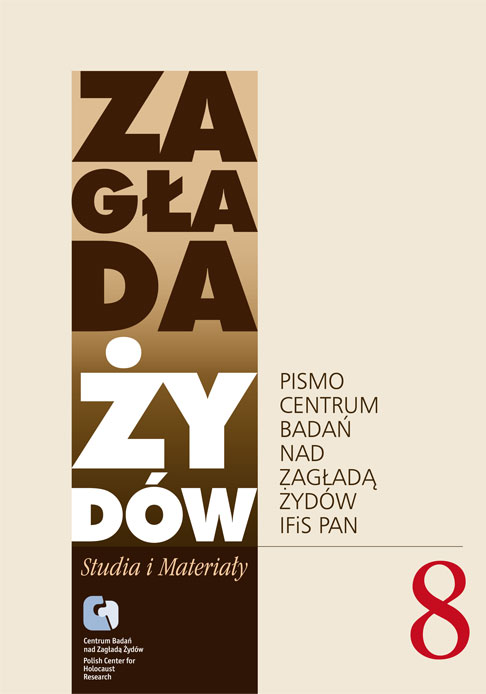O tym, co minęło, lecz nie zostało zapomniane: Badania archeologiczne na terenie byłego obozu zagłady w Treblince
Zagłada Żydów. Studia i Materiały, Nr 8 (2012), Strony: 83-118
Data zgłoszenia: 2020-10-27Data publikacji: 2012-12-02
 https://doi.org/10.32927/ZZSiM.628
https://doi.org/10.32927/ZZSiM.628
Abstrakt
Public impression of the Holocaust is unquestionably centred on knowledge about, and the image of, Auschwitz-Birkenau – the gas chambers, the crematoria, the systematic and industrialized killing of victims. Conversely, knowledge of the former extermination camp at Treblinka, which stands in stark contrast in terms of the visible evidence that survives pertaining to it, is less embedded in general public consciousness. As this paper argues, the contrasting level of knowledge about Auschwitz- Birkenau and Treblinka is centred upon the belief that physical evidence of the camps only survives when it is visible and above-ground. The perception of Treblinka as having been “destroyed” by the Nazis, and the belief that the bodies of all of the victims were cremated without trace, has resulted in a lack of investigation aimed at answering questions about the extent and nature of the camp, and the locations of mass graves and cremation pits. This paper discusses the evidence that demonstrates that traces of the camp do survive. It outlines how archival research and non-invasive archaeological survey has been used to re-evaluate the physical evidence pertaining to Treblinka in a way that respects Jewish Halacha Law. As well as facilitating spatial and temporal analysis of the former extermination camp, this survey has also revealed information about the cultural memory.
Słowa kluczowe
Treblinka , archeologia Zagłady , obóz zagłady , dowody rzeczowe , halacha
Licencja
Prawa autorskie (c) 2012 Autor & "Zagłada Żydów. Studia i Materiały"

Utwór dostępny jest na licencji Creative Commons Uznanie autorstwa 4.0 Międzynarodowe.
https://creativecommons.org/licenses/by/4.0
Inne teksty tego samego autora
- Caroline Sturdy Colls, Gone but not Forgotten: Archaeological approaches to the site of the former Treblinka Extermination Camp in Poland , Zagłada Żydów. Studia i Materiały: Nr Holocaust Studies and Materials (2013)
Podobne artykuły
- Natalia Aleksiun, Robert Kuwałek, Obóz zagłady w Bełżcu, Lublin: Państwowe Muzeum na Majdanku, 2010, 279 s. , Zagłada Żydów. Studia i Materiały: Nr 7 (2011)
- Anna Ziółkowska, Patrick Montague, Chełmno. Pierwszy nazistowski obóz zagłady , Zagłada Żydów. Studia i Materiały: Nr 11 (2015)
- Barbara Engelking, Sny jako źródło do badań nad Zagładą , Zagłada Żydów. Studia i Materiały: Nr 9 (2013)
- Dariusz Libionka, The National Military Organization, the National Armed Forces and the Jews near Kraśnik: A Picture Corrected , Zagłada Żydów. Studia i Materiały: Nr Holocaust Studies and Materials (2013)
- Ewa Wiatr, „Zdawanie Żydów” – udział policjantów granatowych w wysiedlaniu Żydów na przykładzie powiatu radomszczańskiego , Zagłada Żydów. Studia i Materiały: Nr 10 (2014)
- Dariusz Libionka, “Truth About Camps” or the Uneventful 1942 , Zagłada Żydów. Studia i Materiały: Nr Holocaust Studies and Materials (2013)
- Stefan Marcinkiewicz, Sammellager Bogusze (2 listopada 1942 – 3 stycznia 1943 r.) jako przykład przejściowego obozu zbiorczego podczas akcji „Reinhardt” w okręgu białostockim , Zagłada Żydów. Studia i Materiały: Nr 20 (2024)
- Marta Tomczok, Religijny kicz holokaustowy. Zarys zjawiska , Zagłada Żydów. Studia i Materiały: Nr 15 (2019)
- Zuzanna Schnepf-Kołacz, Włoski ogród historii. Rzym, Ferrara, Mediolan – nowe projekty na mapie żydowskich muzeów we Włoszech , Zagłada Żydów. Studia i Materiały: Nr 9 (2013)
- Jerzy Kochanowski, Cisi bohaterowie („Stille Helden”) , Zagłada Żydów. Studia i Materiały: Nr 9 (2013)
<< < 1 2 3 4 5 6 7 8 9 10 11 12 13 14 15 16 17 18 19 20 21 22 23 24 25 26 27 28 29 30 31 32 33 34 35 36 37 38 39 40 41 > >>
Możesz również Rozpocznij zaawansowane wyszukiwanie podobieństw dla tego artykułu.
 English
English
 Język Polski
Język Polski



 https://orcid.org/0000-0003-2942-6219
https://orcid.org/0000-0003-2942-6219





